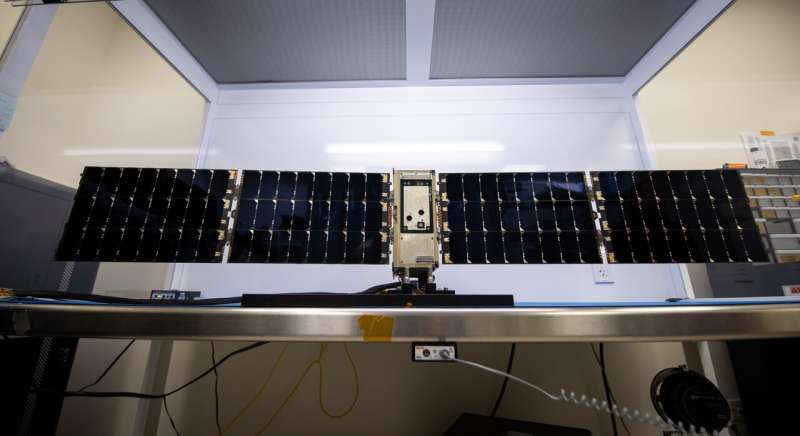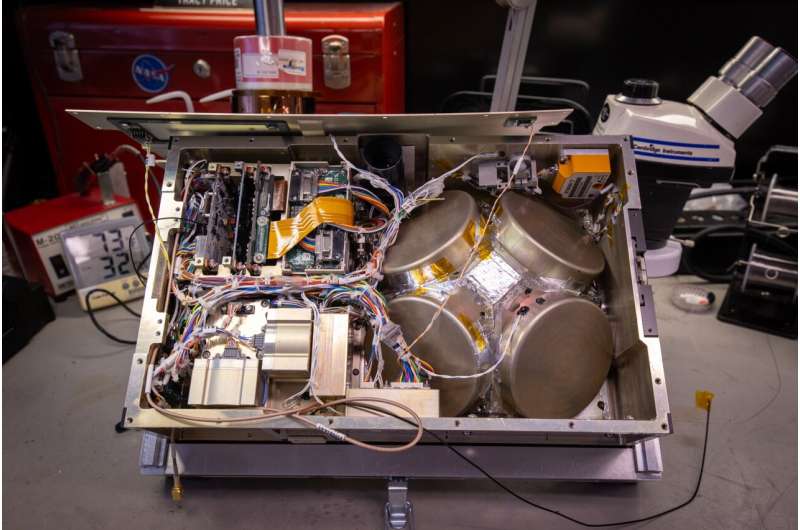
NASA’s BurstCube passes milestones on journey to launch (Image Credit: Phys.org)

Scientists and engineers at NASA’s Goddard Space Flight Center in Greenbelt, Maryland, have completed testing for BurstCube, a shoebox-sized spacecraft designed to study the universe’s most powerful explosions. Members of the team have also delivered the satellite to their partner Nanoracks (part of Voyager Space) in Houston, Texas, where it will be packed for launch.
“Even a satellite as tiny as BurstCube requires extensive verification before it can go to space,” said Goddard’s Lucia Tian, the mission’s science instrument lead. “We characterized its magnetic field, tested it at extreme temperatures, and recreated the shaking it will experience at launch—just to name a few assessments.”
BurstCube will search the sky for short gamma-ray bursts, brief flashes of the highest-energy form of light. Dense stellar remnants called neutron stars create these bursts when they collide with other neutron stars or black holes.
Astronomers are interested in learning more about these collisions because they’re an important source of the universe’s heavy elements, like gold and platinum. BurstCube’s goal is to detect and locate bursts and alert other observatories to coordinate detailed follow-up studies. BurstCube will join a growing network of satellites and telescopes working together to witness changes in the universe as they unfold.
The spacecraft is slated for takeoff in March 2024 from NASA’s Kennedy Space Center in Florida aboard a resupply mission to the International Space Station.

To ensure it can withstand the rattling it will experience at launch, the mission team transported BurstCube to Washington Laboratories in Frederick, Maryland, for vibration testing. Engineers strapped the satellite to a plate, which then vibrated at frequencies ranging from 20 to 20,000 hertz. Translated into sound, that spans bass to the upper limit of human hearing.
BurstCube will use Earth’s magnetic field to orientate itself as it scans the sky. To do so, the mission team had to map the spacecraft’s own magnetic field using a special facility at NASA’s Wallops Flight Facility in Virginia.
“The magnetic calibration chamber generates a known magnetic field that cancels out Earth’s,” said Goddard engineer Kate Gasaway. “Our measurements of BurstCube’s field in the chamber will help us figure out where the satellite is pointing once in space, so we can locate gamma-ray bursts and tell other observatories where to look.”
As BurstCube orbits, it will experience major temperature swings every 90 minutes as it passes in and out of daylight. The team evaluated how the spacecraft will operate in these new conditions using a thermal vacuum chamber at Goddard, where temperatures ranged from minus 4 to 113 degrees Fahrenheit (minus 20 to 45 Celsius).
In addition to these tests, the team ran many other assessments, like software and communications checks and ensuring the solar panels will open uninhibited after deployment from the space station.
“Small missions like BurstCube provide valuable opportunities for early career scientists and engineers to see all aspects of a project from start to finish,” said Jeremy Perkins, BurstCube’s principal investigator at Goddard. “Now that we’ve completed testing, the team and BurstCube are gearing up for the next steps toward launch.”
Provided by
NASA’s Goddard Space Flight Center
NASA’s BurstCube passes milestones on journey to launch (2023, December 18)
retrieved 20 December 2023
from https://phys.org/news/2023-12-nasa-burstcube-milestones-journey.html
part may be reproduced without the written permission. The content is provided for information purposes only.





